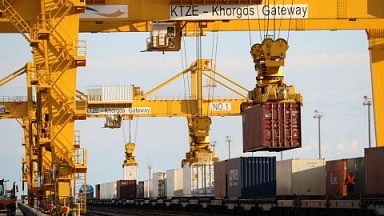Growing competition from maritime shipping services was another important factor. Deep sea freight rates remained below those of rail, making maritime transportation much more appealing.
Rail transportation enjoyed an uncontested advantage over maritime shipments between late 2020 and the middle of 2022 in terms of transportation costs. Nevertheless, in the second half of 2022, maritime transportation reclaimed its lead for the most cost-effective way to ship a container. In 2023, the ERAI index, which measures the cost of transporting a container within the 1520 mm gauge railway network from border to border, remained stable at about $2,900 per FEU, with monthly fluctuations not exceeding 1.5%. At the same time, the WCI composite index was much more volatile with monthly fluctuations reaching 17%.
In 2023, freight traffic on the Eurasian railway route totaled 674 thousand TEUs, down 1.1% compared to 2022, when this indicator stood at 681 thousand TEUs. Transit traffic volumes for the China — EU — China freight segment dropped 49% from 410.6 thousand TEUs to 211.1 thousand TEUs, while the development of other transit segments within the EAEU kept overall container traffic volumes steady, mainly driven by the growing export and import flows between China and Russia/Belarus.
The total number of container trains dropped by 5% to about 7 thousand in 2023, which is attributable to the economic situation and competition from sea shipping. Transits by Chinese and European consignors account for an important share of Eurasian freight rail volume, even though it was the diversification of services which helped maintain traffic volumes at a relatively high level.
The Eurasian corridor remains dominant in China — Europe — China freight service, passing through Belarus, Kazakhstan and Russia. According to statistics at border crossings (Dostyk and Altynkol), it accounts for 96% of all container traffic. Container transits through Naushki crossing dropped 93.9% to 1.5 thousand TEU, while transit through Zabaikalsk were down 72.3% to 4.9 thousand TEU, despite a persistent effort to develop railway infrastructure on the Trans-Siberian routes. The border crossings in the Russian Far East did not receive any China-Europe-China container traffic in 2023.
In 2023, Eurasian freight rail route demonstrated its ability to respond to international and political challenges. The longstanding effort to develop Eurasian container freight transportation paid off. The coordinated rate policy across the 1520 mm gauge network helped maintain steady freight volumes, external challenges notwithstanding, which was not the case for maritime freight rates. They may offer lower rates compared to rail transportation but are more volatile and unstable.



